How Many Chickens Are in the World in 2023? (Chicken Statistics)
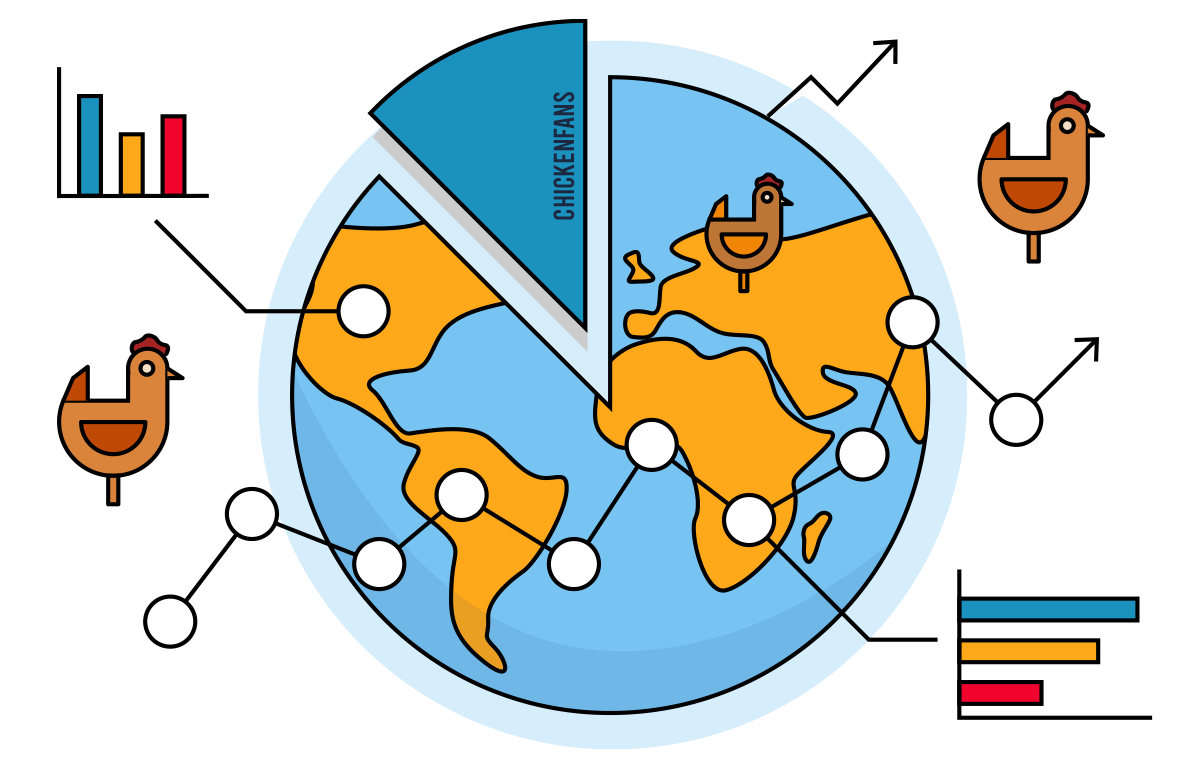
Chickens are the most abundant and widespread domestic livestock in the world. The total number of chickens worldwide has tripled since 1990, from 10.6 billion birds to over 34.4 billion in 2023.
The spectacular growth results from the rising global demand for eggs and meat. Unfortunately, this all comes with a price. Chickens are the most abused animals on the planet. Chickens in the poultry industry have short lifecycles and high feed conversion ratios, and there is much to discuss regarding animal welfare.
The coronavirus pandemic has further accelerated the popularity of backyard poultry since 2020. Backyard chickens are ideal for animal companionship and provide an environmentally sustainable way of getting fresh eggs and food.
Here is a summary of what you’ll learn in this statistical roundup:
- Chicken Population Statistics (Top Picks)
- Evolution of the worldwide chicken population
- Top 10 chicken countries ranked by population
- Top 10 chicken states in the US
- Top 10 chicken countries in Europe
- Top 10 chicken countries in Asia
- Top 10 chicken countries in Africa
- Number of chickens in Oceania
- Global Chicken population per continent
- Chicken Distribution and Density
- Number of chickens slaughtered per year
Chicken Population Statistics (Top Picks)
- There are over 34.4 billion chickens in the world in 2023
- There are 9.22 billion chickens in the US
- Roughly 46% of chickens worldwide are in Asia
- Roughly 28% of chickens worldwide are in the US
- France has 242 million chickens, the most of all European countries
- Iowa has 60.1 million chickens, the highest number of chickens in a US state
Evolution of the worldwide chicken population
The total number of chickens worldwide has tripled in 30 years since 1990, from 10.6 billion birds to 33.097 billion chickens in 2020.
The last official estimates by FAO indicate that the global chicken population was roughly 33 billion for the last three years before 2020, with 32.6 billion chickens in 2018, 33.2 billion in 2019, and 33.1 billion chickens in 2020.
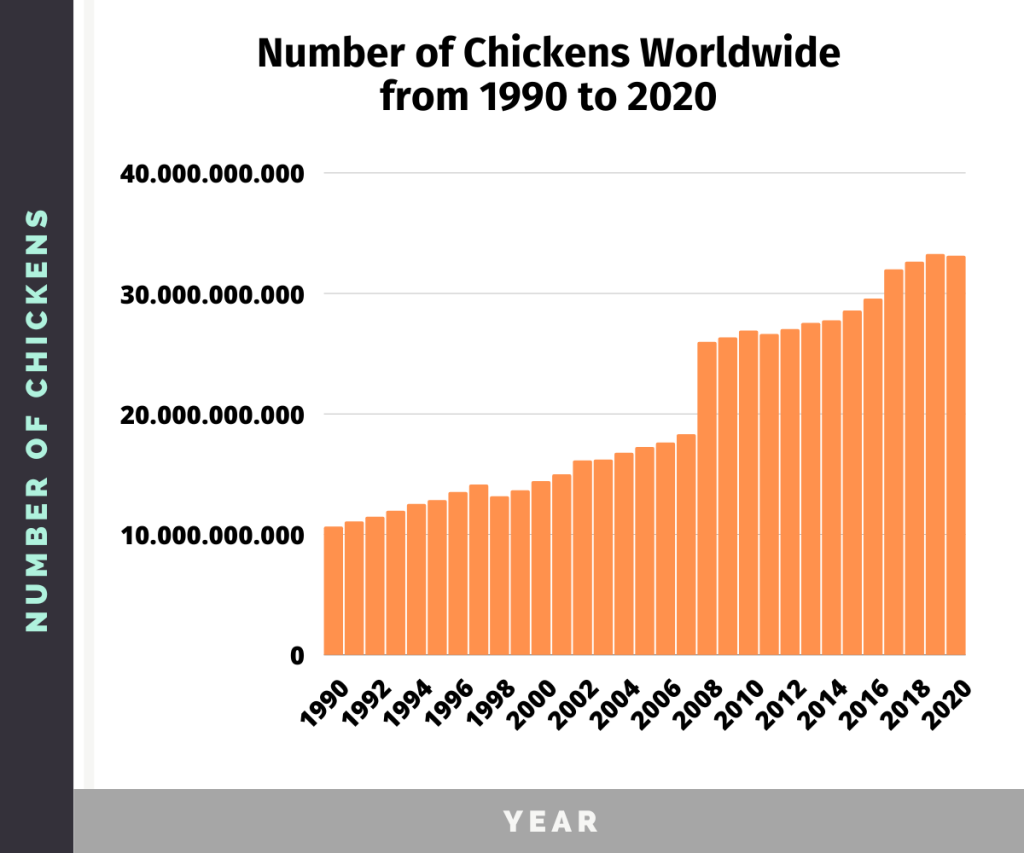
Here is the table of the number of chickens worldwide every five years:
| Year | Number of Chickens Worldwide |
|---|---|
| 1990 | 10.6 billion |
| 1995 | 12.8 billion |
| 2000 | 14.4 billion |
| 2005 | 17.2 billion |
| 2010 | 26.9 billion |
| 2015 | 28.5 billion |
| 2020 | 33.1 billion |
The global coronavirus pandemic in 2020 affected 7.79 billion people and made backyard chickens increasingly popular. Before the pandemic, roughly 8% of US households had chickens in the US, which accounted for 10 million backyard flocks.
With backyard poultry on the upswing all over, backyard chicken flocks are estimated to be increased by half as much since 2018 despite a global bird flu crisis.
Currently, there are approximately 34.4 billion chickens in the world.
Source: FAO; USDA; APPA; CBS; data last accessed 01/2023
Top 10 chicken countries ranked by population
According to the Food and Agriculture Organization of the United Nations, the US has more chickens than any other country, with the last official count of 9.22 billion chickens in 2020.
The combined chicken population located in the top 3 exceeds half of the global population, with 18 billion chickens found in Indonesia, China, and the US.
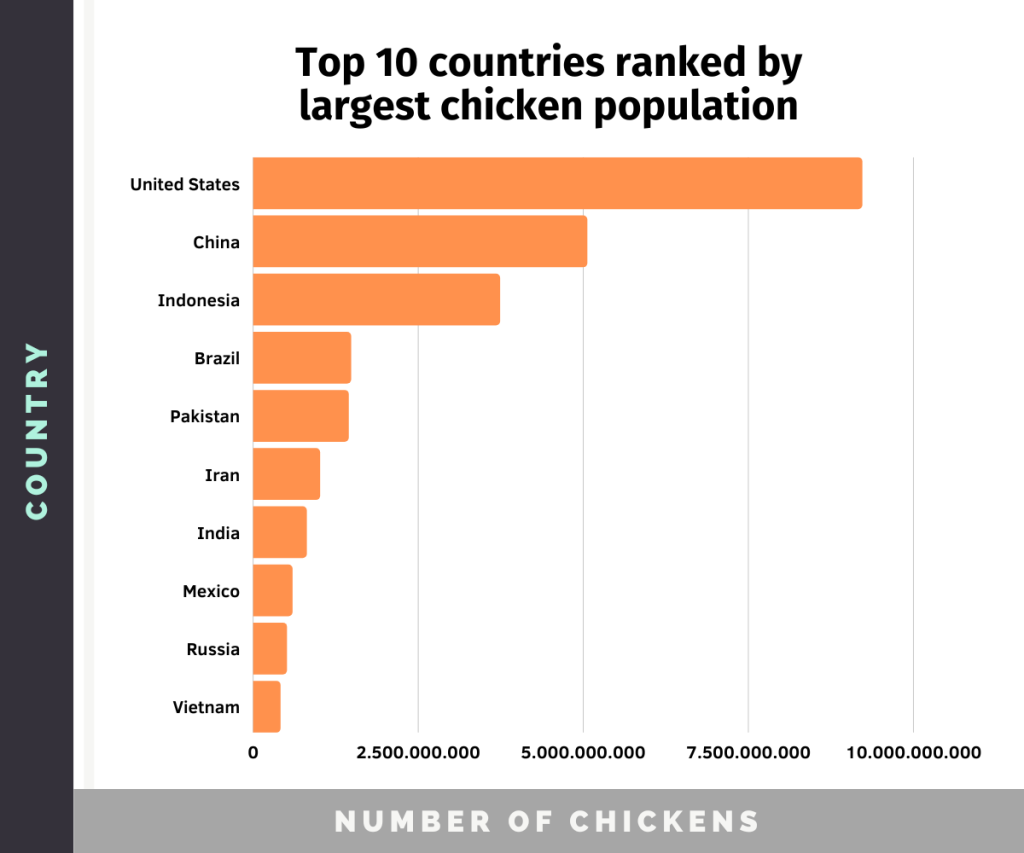
Here’s the table of the ten countries with the most chickens, ranked by the number of chickens:
| Country | Number of Chickens |
|---|---|
| United States | 9.22 billion |
| China | 5.06 billion |
| Indonesia | 3.74 billion |
| Brazil | 1.48 billion |
| Pakistan | 1.44 billion |
| Iran | 1.01 billion |
| India | 807 million |
| Mexico | 592 million |
| Russia | 507 million |
| Vietnam | 410 million |
Source: FAO; data accessed 01/2023
Top 10 chicken states in the US
Iowa has more than 60 million chickens and has the highest number of chickens in the US. Iowa has more than 18 chickens for every living Iowan.
Ohio and Indiana are competing neck-to-neck for the second place, with just over 45 million chickens in 2021, according to the United States Department of Agriculture.
Ohio has about 4 chickens per Ohioan. Indiana has roughly 7 chickens per Hoosier.
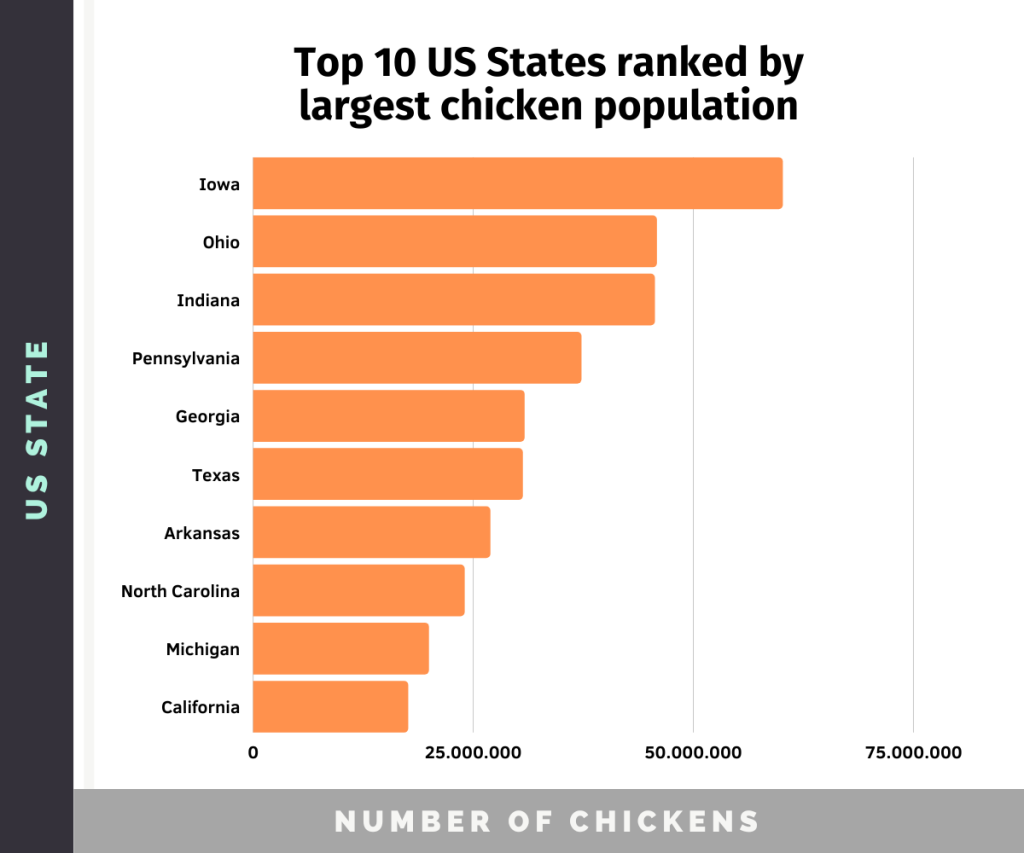
In October 2022, USDA reported that 373 million chickens in the US are laying hens. That’s more than the entire chicken population of France.
Most laying hens produce table eggs, but 62.5 million produce broiler-hatching eggs. These meat chickens are slaughtered after 40 days.
Source: FAO; USDA; data last accessed 01/2023
Top 10 chicken countries in Europe
Europe has 2.35 billion chickens.
According to the Food and Agriculture Organization of the United Nations, France has more chickens than any other European country, with the last official count of 242.015 million chickens in 2020.
France has roughly half of the Russian chicken population, which is – geographically – also part of Europe. The Russian Federation houses 496.96 million chickens.
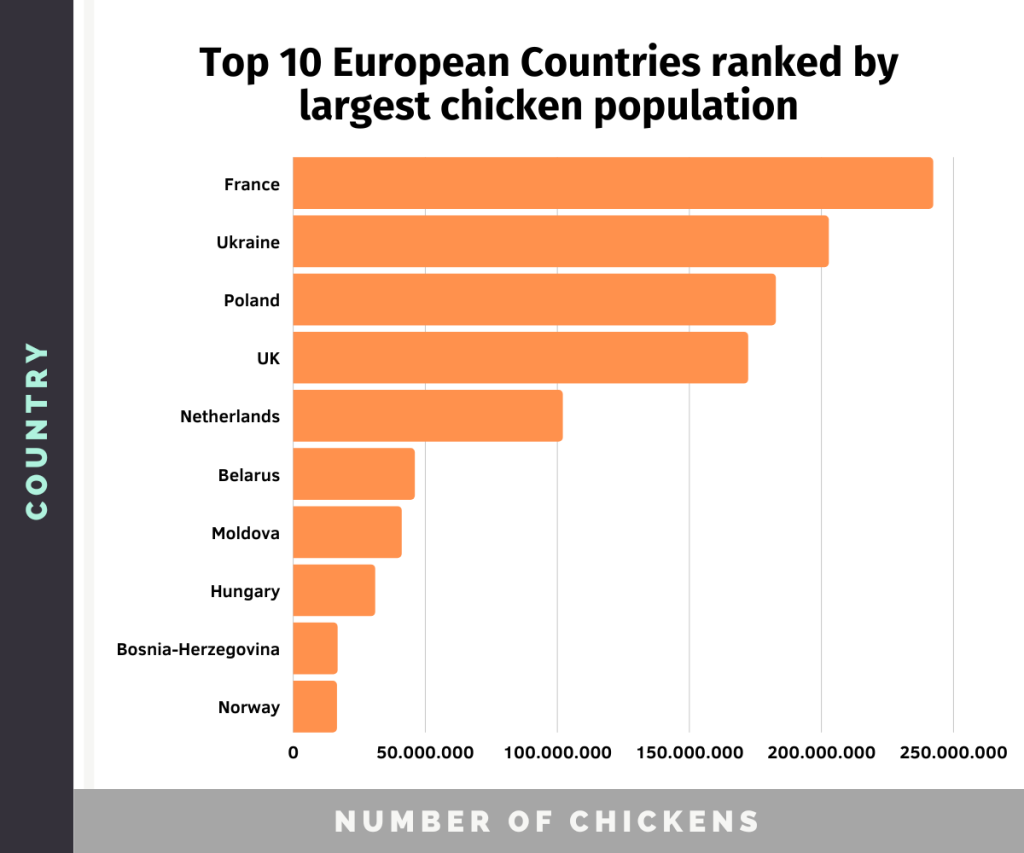
The poultry industry in Ukraine was heavily disrupted when Russia invaded Ukraine on 24 February 2022. With the war still going on in 2023 and Ukraine being a major wheat, sunflower, corn, and soy producer, this disruption is felt in many other European countries, the Middle East, and North Africa. Poultry production plummeted after major power cuts hit the breadbasket of Europe.
Here’s the table of the ten countries in Europe with the most chickens, ranked by the number of chickens in 2020:
| Country | Number of Chickens |
|---|---|
| France | 242 million |
| Ukraine | 202.5 million |
| Poland | 182.5 million |
| United Kingdom of Great Britain and Northern Ireland | 172 million |
| Netherlands | 101.9 million |
| Belarus | 45.9 million |
| Republic of Moldova | 40.9 million |
| Hungary | 30.8 million |
| Bosnia and Herzegovina | 16.6 million |
| Norway | 16.4 million |
Norway finishes in the top ten with its cold climate and tough winters. Cold-hardy chickens are also kept in other frigid climates like Finland (8.5 million) and Sweden (10.8 million). Even Iceland houses 222 thousand chickens.
Source: FAO; data accessed 01/2023
Top 10 chicken countries in Asia
Almost half of the world’s chicken population is located in Asian countries.
Asia harbors 15.4 billion chickens, which is 46% of all the chickens in the world in 2020.
The combined chicken population located in the top 3 is just short of 10 billion chickens, with a staggering 9.8 billion chickens located in China, Indonesia, and Pakistan.
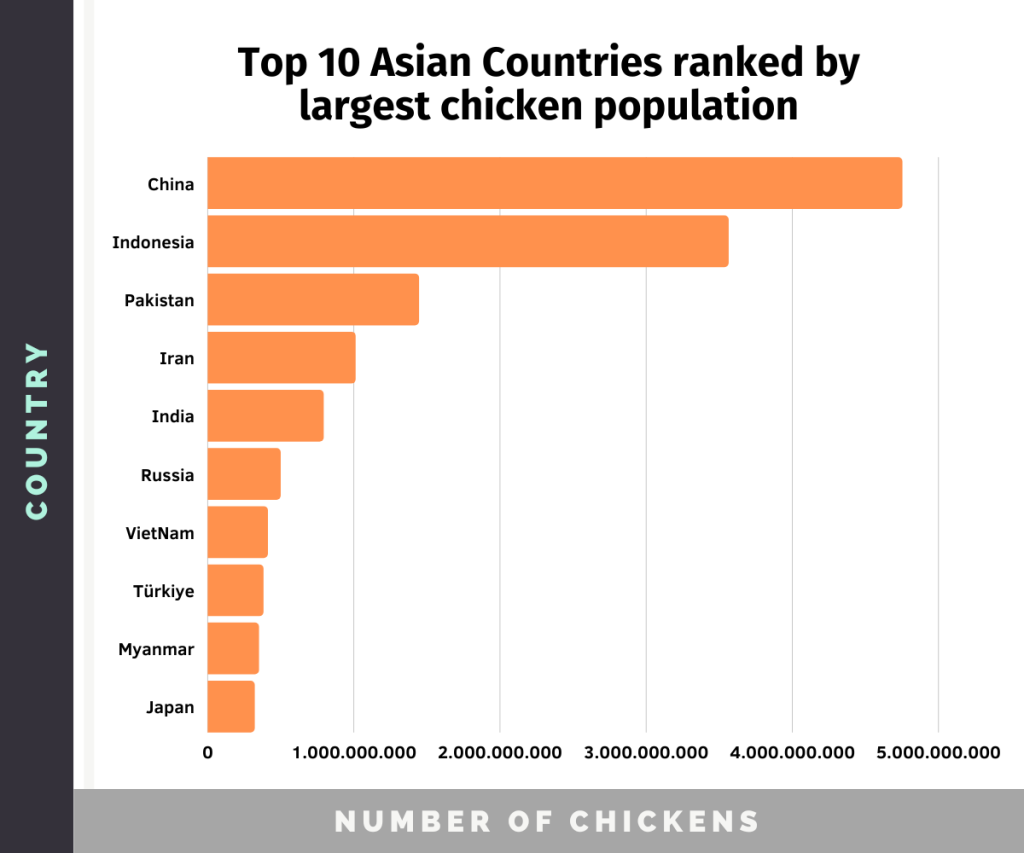
Here’s the table of the ten countries in Asia with the most chickens, ranked by the number of chickens:
| Country | Number of Chickens |
|---|---|
| China | 4.75 billion |
| Indonesia | 3.56 billion |
| Pakistan | 1.44 billion |
| Iran | 1.01 billion |
| India | 791 million |
| Russian Federation | 497 million |
| Vietnam | 410 million |
| Türkiye | 379 million |
| Myanmar | 349 million |
| Japan | 320 million |
Source: FAO; data accessed 01/2023
Top 10 chicken countries in Africa
Africa has a total of 2.07 billion chickens.
The chicken population in Africa is pretty evenly distributed over the African countries. Marocco has 208 million chickens, which is the most of all African countries.
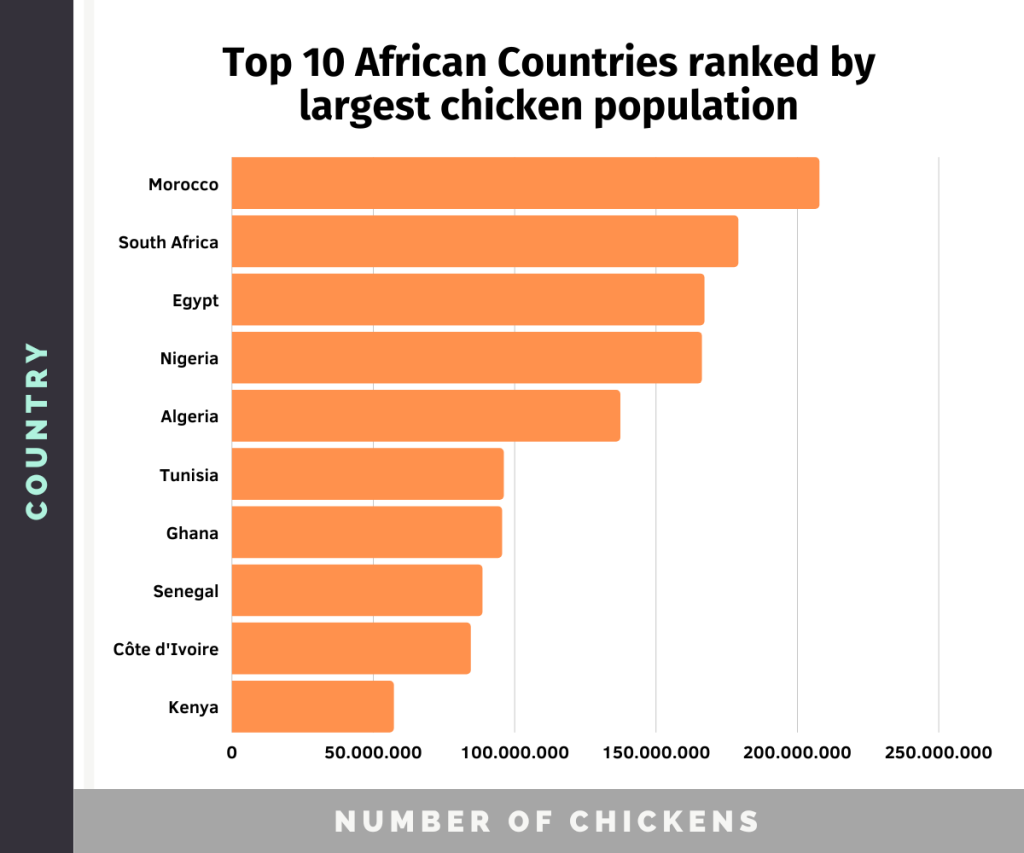
Here’s the table of the ten countries in Africa with the most chickens, ranked by the number of chickens:
| Country | Number of Chickens |
|---|---|
| Morocco | 207.7 million |
| South Africa | 179 million |
| Egypt | 167 million |
| Nigeria | 166.1 million |
| Algeria | 137.3 million |
| Tunisia | 96 million |
| Ghana | 95.5 million |
| Senegal | 88.5 million |
| Côte d’Ivoire | 84.4 million |
| Kenya | 57.2 million |
Senegal has the eighth spot with a scorching climate. Many chicken breeds are heat-hardy and can survive in the hottest climates in Mali (5.2 million chickens) and Burkina Faso (3.98 million chickens).
Source: FAO; data accessed 01/2023
Number of chickens in Oceania
There are 139.15 million chickens in Oceania.
Most chickens are located in Australia and New Zeeland:
- Australia has 100.8 million chickens
- New Zeeland has 24.8 million chickens
Next on the list are Fiji (5.48 million chickens) and Papua New Guinea (4.59 million chickens). Kiribati, Vanuatu, Caledonia, and Samoa have roughly half a million chickens.
Source: FAO; data accessed 01/2023
Global Chicken population per continent
About 46% of all chickens in the world are located in Asia.
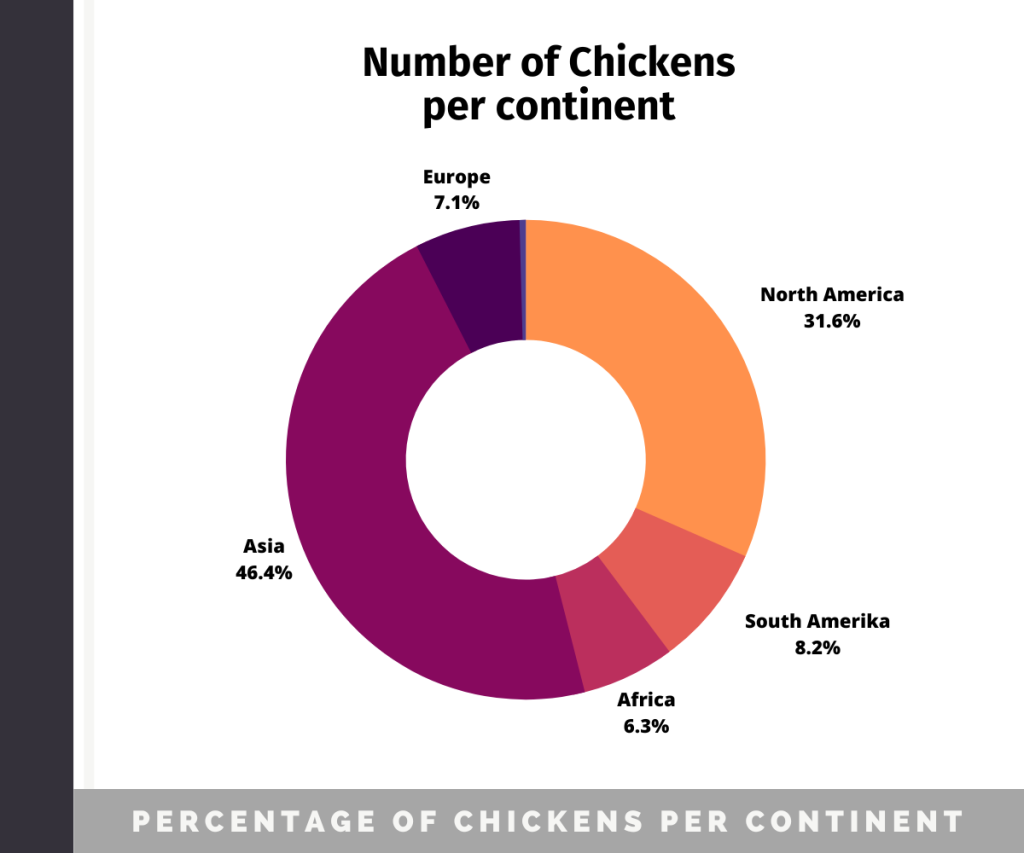
Here’s the table of the number of chickens per continent:
| Continent | Number of chickens |
|---|---|
| North America | 10.455 billion |
| South Amerika | 2.709 billion |
| Africa | 2.073 billion |
| Asia | 15.373 billion |
| Europe | 2.348 billion |
| Oceania | 139.15 million |
The value of North America is the combined number of chickens for North America (9.39 billion chickens), the Caribbean (291.4 million chickens), and Central America (769.4 million chickens).
For Oceanea, most chickens are located in Australia and New Zeeland:
- Australia has 100.8 million chickens
- New Zeeland has 24.8 million chickens
Next on the list are Fiji (5.48 million chickens) and Papua New Guinea (4.59 million chickens). Kiribati, Vanuatu, Caledonia, and Samoa have roughly half a million chickens.
Source: FAO; data accessed 01/2023
Chicken Distribution and Density
Where there are humans, there are chickens. The distribution of chickens closely follows that of the human population.
There are more than 4 chickens per person on the planet, with 33.097 billion chickens for 7.764 billion persons in 2020.
Regions with densely populated chicken populations have a major environmental impact and play a role in epidemic outbreaks and public health.
Here is a table with the highest chicken concentrations in the world:
| Concentration of Chickens | Density chickens/km2 | Regions |
|---|---|---|
| Highest concentration | > 10.000 | Eastern China Pakistan India Western Europe Populated areas in Southern Brazil |
| Densely populated | 500-1000 | East Coast of the US African countries facing the Gulf of Guinea Madagascar |
Chickens are sparsely distributed in the central and western states of the United States but densely populated on the East Coast.
Source: GLW2 Livestock Density Maps; FAO; CAJOTAS; data accessed 01/2023
Number of Chickens Slaughtered per Country
Many broilers and laying hens die daily to provide meat and table eggs.
To maintain a high productivity rate, many egg-laying chickens are slaughtered every day. The lay-per-day rate in the US for January 2022 is 79.3 eggs per 100 egg-laying hens. These chickens are called ‘spent’ egg-laying hens and are slaughtered when their egg-laying slows down.
The US slaughtered 9.35 billion chickens in 2021, or 25.6 million chickens daily. Of those slaughtered chickens, 9.21 billion were young chickens, 36.3 million were light, mature hens, and less than 1% (78.3 million) were heavy mature chickens.
China slaughtered 9.29 billion chickens in 2021, which is an average of 25.5 million chickens killed daily to maintain high productivity rates.
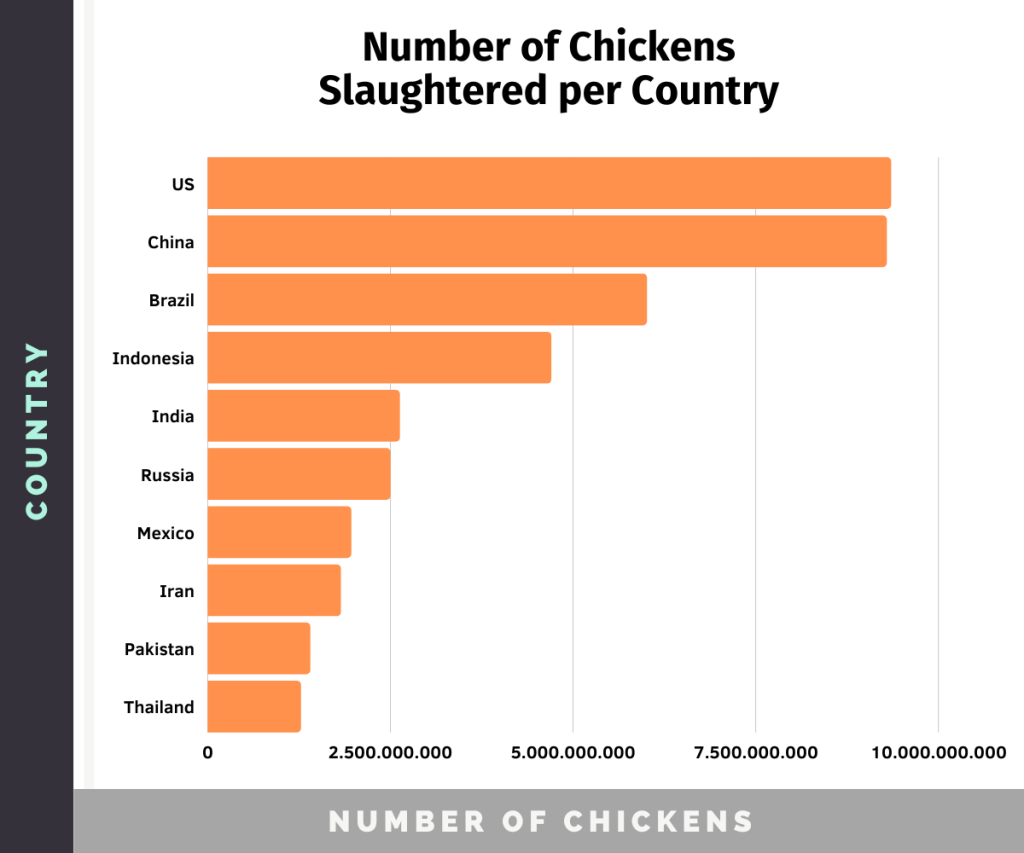
Male chicks are usually slaughtered on their first day in the poultry industry. They are less suitable for meat production than broiler breeds and can’t lay eggs*.
Sustainable egg farms like Kipster are rising, keeping roosters alive and raising them for meat. Kipster opened its first US layer farm in Indiana in January 2023.
Here is a table of slaughtered chickens per country for countries that killed more than 1 billion chickens in 2021:
| Country | Number of Slaughtered Chickens |
|---|---|
| United States | 9.35 billion |
| China | 9.2 billion |
| Brazil | 6 billion |
| Indonesia | 4.7 billion |
| India | 2.63 billion |
| Russia | 2.5 billion |
| Mexico | 1.96 billion |
| Iran | 1.82 billion |
| Pakistan | 1.4 billion |
| Thailand | 1.27 billion |
| Myanmar | 1.22 billion |
| Poland | 1.18 billion |
| United Kingdom | 1.15 billion |
| Philippines | 1.12 billion |
| Republic of Korea | 1.06 billion |
| Colombia | 1.01 billion |
| Egypt | 1.01 billion |
* Note that it is difficult to validate whether all countries included spent hens and roosters in their slaughter statistics reported to FAO.
The number of chickens slaughtered has been rising since the sixties and is now tenfold of the 6.58 billion chickens in 1960.
A total of 72.45 billion chickens were slaughtered worldwide in 2019, which is 198.5 million chickens slaughtered daily on average.
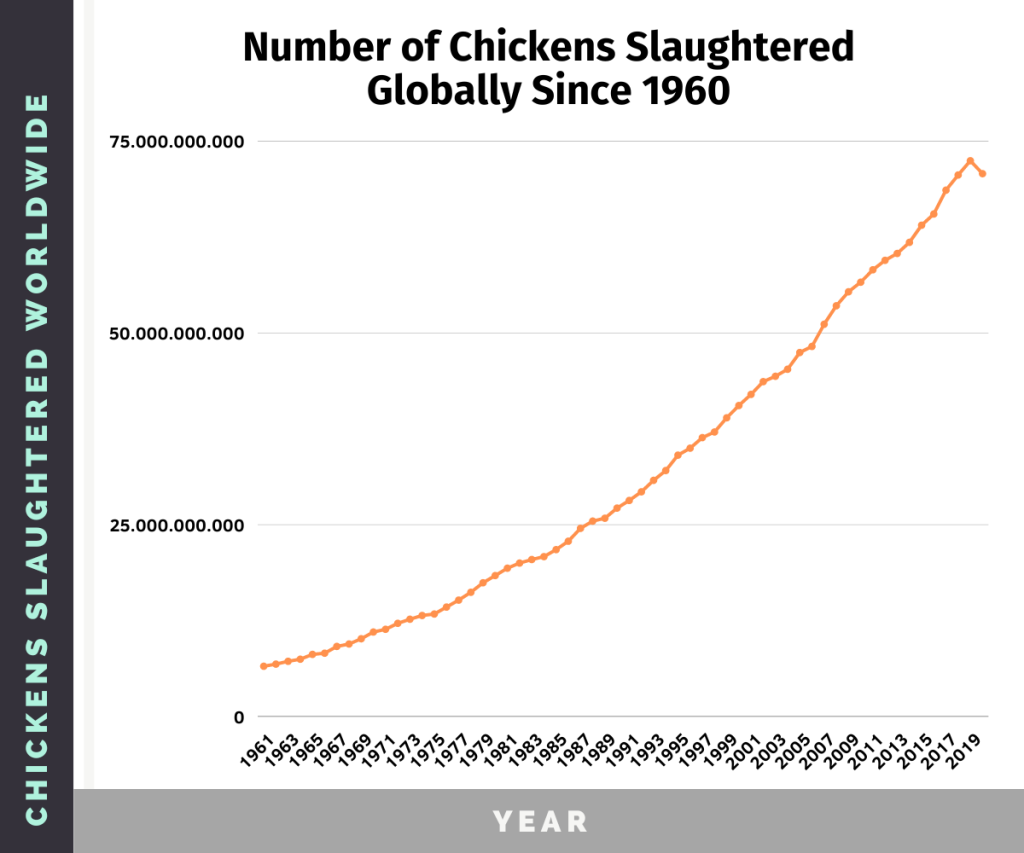
In 2022, many chickens died due to the highly pathogenic avian influenza outbreak. These numbers will add to the chickens that died, were destroyed, or disappeared for any reason apart from being sold for a few cents per pound.
It will be interesting to see whether slaughter rates have passed the peak in 2020 and will decrease now the FDA has approved the first human food made using animal cell culture technology in November 2022.



















